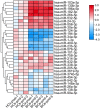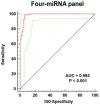A four-miRNA signature in serum as a biomarker for bladder cancer diagnosis
- PMID: 35958461
- PMCID: PMC9360833
A four-miRNA signature in serum as a biomarker for bladder cancer diagnosis
Abstract
Background: Urinary bladder cancer (BCa) is globally the 10th most frequent cancer. As a novel diagnostic tool, miRNA in serum screening is non-invasive. This project aimed to determine particular serum miRNAs as novel biomarkers for diagnosing urinary BCa.
Methods: We designed a three-phase study with 122 healthy controls (HCs) and 132 BCa patients. The 30 miRNAs' expressions in serum from HCs and BCa patients were detected during the screening phase. The miRNAs with the most dysregulation were tested in the training (HCs vs. BCa, 30 each) and validation (80 HCs vs. 82 BCa) phase further. The diagnostic ability of these candidate miRNAs was estimated by the receiver operating characteristic (ROC) curves as well as the area under the ROC curve (AUC). The miRNAs' target genes and their annotations to functions were predicted utilizing bioinformatic assays.
Results: Six serum miRNAs (miR-124-3p, miR-182-5p, miR-1-3p, miR-196a-5p, miR-23b-3p and miR-34a-5p) had significantly different expression between BCa patients and HCs in the training and validation phase. The four-microRNA panel improved the diagnostic value, with AUC =0.985. The result of bioinformatic analysis showed that these miRNAs' target genes in the panel may be related to the MAPK signaling pathway in bladder cancer.
Conclusions: Our study identified a four-miRNA panel that is a non-invasive new biomarker for diagnosing BCa.
Keywords: Bladder cancer; bioinformatics; biomarker; diagnosis; miRNA.
AJTR Copyright © 2022.
Conflict of interest statement
None.
Figures






Similar articles
-
Identification of a three-miRNA panel in serum for bladder cancer diagnosis by a diagnostic test.Transl Cancer Res. 2022 May;11(5):1005-1016. doi: 10.21037/tcr-21-2611. Transl Cancer Res. 2022. PMID: 35706801 Free PMC article.
-
The diagnostic value of a breast cancer diagnosis model based on serum MiRNAs and serum tumor markers.World J Surg Oncol. 2025 Mar 29;23(1):109. doi: 10.1186/s12957-025-03719-z. World J Surg Oncol. 2025. PMID: 40158122 Free PMC article.
-
A Four-MicroRNA Panel in Serum as a Potential Biomarker for Screening Renal Cell Carcinoma.Front Genet. 2022 Jul 22;13:897827. doi: 10.3389/fgene.2022.897827. eCollection 2022. Front Genet. 2022. PMID: 35938021 Free PMC article.
-
miRNA-143 as a potential biomarker in the detection of bladder cancer: a meta-analysis.Future Oncol. 2024;20(18):1275-1287. doi: 10.2217/fon-2023-0922. Epub 2024 May 9. Future Oncol. 2024. PMID: 38722138 Free PMC article.
-
Urinary miRNAs as a Diagnostic Tool for Bladder Cancer: A Systematic Review.Biomedicines. 2022 Oct 31;10(11):2766. doi: 10.3390/biomedicines10112766. Biomedicines. 2022. PMID: 36359288 Free PMC article. Review.
Cited by
-
The relationship between microRNAs and bladder cancer: are microRNAs useful to predict bladder cancer in suspicious patients?Int Urol Nephrol. 2023 Oct;55(10):2483-2491. doi: 10.1007/s11255-023-03666-2. Epub 2023 Jun 20. Int Urol Nephrol. 2023. PMID: 37338656
-
MicroRNA-34 Family in Cancers: Role, Mechanism, and Therapeutic Potential.Cancers (Basel). 2023 Sep 26;15(19):4723. doi: 10.3390/cancers15194723. Cancers (Basel). 2023. PMID: 37835417 Free PMC article. Review.
-
Characterization of a miRNA Signature with Enhanced Diagnostic and Prognostic Power for Patients with Bladder Carcinoma.Int J Mol Sci. 2023 Nov 13;24(22):16243. doi: 10.3390/ijms242216243. Int J Mol Sci. 2023. PMID: 38003433 Free PMC article.
References
-
- Bray F, Ferlay J, Soerjomataram I, Siegel RL, Torre LA, Jemal A. Global cancer statistics 2018: GLOBOCAN estimates of incidence and mortality worldwide for 36 cancers in 185 countries. CA Cancer J Clin. 2018;68:394–424. - PubMed
-
- Laaksonen MA, MacInnis RJ, Canfell K, Giles GG, Hull P, Shaw JE, Cumming RG, Gill TK, Banks E, Mitchell P, Byles JE, Magliano DJ, Hirani V, Connah D, Vajdic CM. The future burden of kidney and bladder cancers preventable by behavior modification in Australia: a pooled cohort study. Int J Cancer. 2020;146:874–883. - PubMed
-
- Siegel RL, Miller KD, Jemal A. Cancer statistics, 2019. CA Cancer J Clin. 2019;69:7–34. - PubMed
-
- Miller KD, Nogueira L, Mariotto AB, Rowland JH, Yabroff KR, Alfano CM, Jemal A, Kramer JL, Siegel RL. Cancer treatment and survivorship statistics, 2019. CA Cancer J Clin. 2019;69:363–385. - PubMed
-
- Sanli O, Dobruch J, Knowles MA, Burger M, Alemozaffar M, Nielsen ME, Lotan Y. Bladder cancer. Nat Rev Dis Primers. 2017;3:17022. - PubMed
LinkOut - more resources
Full Text Sources
Research Materials
